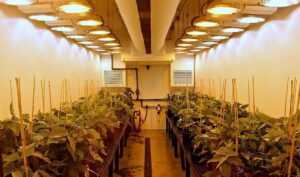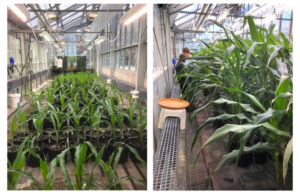Legacy to LED Lighting Retrofit Strategies for Research Facilities
More and more horticultural research facilities and greenhouse research operations have started to switch from older legacy HID lights and look at alternatives, such as the more modern, energy-efficient LED grow lights.
Why should I transition from my legacy grow lights to LEDs?
Although growers often look to horticultural researchers for data and advice on the latest trends in crop production and greenhouse efficiencies, grow lighting is an area where commercial growers have already started adopting advanced LED lighting technologies far more rapidly than most horticultural universities and colleges. To maintain the relevancy of your lighting research studies and better equip your graduates for real-world experience, the argument to switch to LEDs has never been more compelling.
The Cost of Installing LEDs: A Hybrid Lighting System is Less Expensive and might work for you
Yes, since they cost significantly more than an HPS equivalent, installing LED lights is a significant capital expense. As a researcher in an educational facility, you have to make the best choices on where to spend your money. Another factor to consider is that with a full LED retrofit — because of the directional distribution of light — you will likely need to invest in additional wiring and/or track to install more lights than you had for your HID installation. However, there is a way to save costs by moving forward with a hybrid solution. Here, you replace some of your HID luminaires with LEDs, (and leave other HIDs installed). This can help lower your overall or capex (capital expenditure) costs by using the existing infrastructure, allowing for a shorter payback period and several other benefits.
Older HID luminaires are becoming more difficult to maintain and repair
If you are still running old magnetic lights in your facility or want to upgrade these systems in your research greenhouse, you may find it harder to locate replacement parts as this technology has become obsolete. As such, your only current options are to purchase a stockpile of replacement lamps and other parts to keep your facility going or upgrade your lighting to newer high-efficiency electronic HID or LED lighting.
What do I need to know if I am thinking of switching from HID lights to LED lights in my research greenhouse?
So, if you are wondering whether you should switch your old legacy lighting in your research greenhouse to high-efficiency LEDs, then here are some factors you should take into consideration:
Lighting and Performance:
When transitioning to LEDs, most companies will help you create a light plan to ensure that the new lights achieve the same target level of micromoles and uniformity. One issue about LEDs is that the light is very directional whereas, with HPS, the luminaires use reflectors to spread the light over a wider area. In turn, you might need to install more LEDs to achieve the same uniformity as an HID installation. Nowadays, some companies are designing their LED grow lights to offer more flexibility in light distribution. For example, the TriPlane, an offering from P.L. Light Systems, features field-adjustable LED modules that can be tilted to deliver customized distribution over the crop area.
Heat Transfer: LEDs use less energy and produce less heat
One of the greatest differences when transitioning from legacy HID lights to LEDs is the reduction in energy consumption and radiant heat output while still achieving the required light. Less heat works well for any research facility growing plants that flourish in cooler temperatures, such as strawberries or leafy greens. At an indoor facility, lower heat can also help put less strain on an HVAC system. However, in colder climates, many growers rely on the extra heat generated by HPS to help heat their greenhouses and maintain optimal leaf temperatures in the winter. A hybrid application might be an ideal solution since it allows you to take advantage of radiant heating from the HPS luminaires during the winter months while turning on the LEDs in spring/fall to extend the daylight hours without creating additional heat in the greenhouse.
Spectral Choices – Which one is best for your research facility?
Since one of the key advantages of LED technology is the ability for spectral tuning, there has been much excitement in the research community to trial different spectral recipes in the hopes of defining the optimal formulae for specific crops. However, since different crops/cultivars all have various light requirements throughout the growth stages, we typically recommend a red/white/blue spectral recipe for greenhouse applications (where the natural sunlight can compensate for any deficiencies) and a broad spectrum white light for sole source indoor applications.
In a hybrid lighting system with a combination of HPS (with wavelengths that dominate in the red spectrum) and LEDs (which often have higher blue ratios), your plants will receive a broader spectrum of light, enabling them to grow better. This can, in turn, benefit crop performance like yields, quality, crop times, etc. With a hybrid layout, it’s important to work with a knowledgeable partner who understands both HID and LED technologies to ensure uniformity with the spectrum level.
What you need to know before Installing LED Luminaires
Many different lighting companies offer LED grow lights. If you are considering switching your legacy HIDs to LEDs in your research greenhouse, the best place to start is to look at your needs before determining which lighting company(ies) meet your needs. Remember, most lighting companies should provide a professional light plan, full and tested specs on the lights they sell (Do they have DLC certification?), where lights are manufactured, and so on. You’ll also want to learn about warranties, service plans, and after-sales services. It’s also worth checking if your facility can qualify for energy rebates, and if there are grants in your area to help with upgrades.
If I want to upgrade my lighting system to LEDs, what do I need to do?
With all these factors to consider, we understand that choosing to move from legacy lighting to more modern, energy-efficient LEDs or a hybrid lighting combination can be daunting. We always suggest that you engage the services of a professional lighting company that will outline all your costs and expected cost savings to develop a professional lighting plan based on your specific needs and objectives. You can always reach out to a company like P.L. Light Systems. We have been providing lighting to growers and researchers for over 40 years and will make sure you get exactly what you need to continue your important work.
Questions?
If you have questions regarding how best to switch your old HID legacy luminaires to LED grow lights, available energy rebates in your area, light plans, or more, please feel free to connect to a P.L. Light Systems sales expert.




